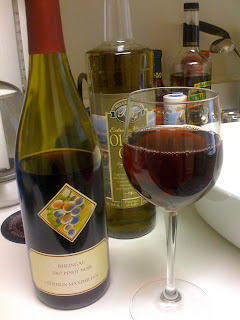For some reason, I've been mulling over this amazing chickpea stew I had in Assisi, a town in Perugia, Italy, famous for St. Francis. This dish made me redefine how I saw chickpeas and value them beyond "healthy thing" or "thing to be pureed into hummus." It was a simple dish with chickpeas, tomatoes, olive oil, and fresh rosemary sprigs, all baked in individual clay pots to the point where the chickpeas reached a consistency of tender veal and blended with all of the simple but strong flavors in one happy, clean tasting food melange.
My own dish was a less simple and highly improvised.
Chickpea stew with baby beet greens and swiss chard
Sautee fresh garlic greens in a little bit of olive oil in a non-stick pan or heavy bottomed skillet. Add an entire washed, spun and chopped bunch of baby beet greens including stalks into the pan and cook until greens are wilted and stalks translucent. Add an entire washed, spun and chopped bunch of swiss chard into the mixture in batches until all the greens are just cooked through. Place cooked greens in a separate bowl and put pan back on the stove top.
If needed, add another swig of olive oil and sautee diced sweet baby peppers (approximately 3-4) and 2 large chopped ripe tomatoes. While the mixture is cooking, empty a can of chickpeas into a colander and wash several times. Add the chickpeas into pan and let simmer on the stovetop for at least 10 - 15 minutes.
Place the cooked greens mixture and the chickpeas in an ovenproof casserole with cover. Add sliced fresh basil and fresh thyme, salt and red pepper to taste, and another dash of olive oil. Stir gently, cover, and place casserole in a pre-heated oven at 350 degrees. Let the stew cook at least 30 minutes, remove from heat, adjust seasoning to taste and serve.


The final product:
I found the dish went wonderfully with this German Pinot Noir (who knew the Germans made good pinot?) and ate it on its own with blackberries and a wedge of stilton for dessert.

Happy cooking.
E.



